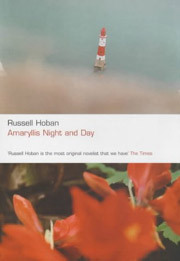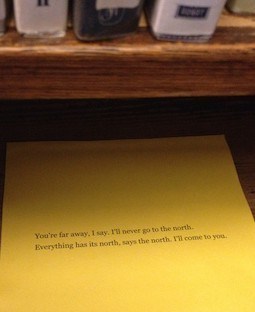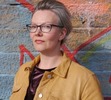Jane Alexander's Blog, page 3
July 13, 2015
The room can write the book
A few weeks ago I took the plunge, and rented an external brain.
This is not the opening line of a science fiction story (though, hmm, maybe it could be…). My external brain is a studio: a corner of an industrial building, a partitioned space shared with eight artists. A bookshelf and a reading armchair, an office chair and writing desk, and a good long surface for laying out pages and making plans – plus a stretch of wall-space, so I can draw out structures and schedules on huge flip-chart sheets.
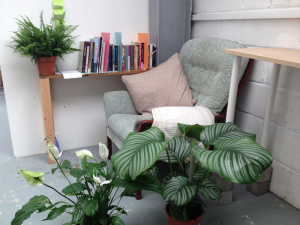 The reading chair
The reading chairI first came across the notion of a room as an external brain in Vincent Deary’s How We Are. Early on in the book he recounts how, before he started to write, he organised his workroom: ‘collecting and ordering the books, papers and articles into one space. I mapped the shape of this book onto a wall chart … I filled a filing cabinet with files, one for each chapter …. I spent several years getting this book out of my mind, and then two months spreading it all over this little room.’ Now, he says, the room can write the book.
The room can write the book. What an appealing idea that is. I’ve been writing at home for a decade, decamping to libraries and coffee shops when cabin fever strikes. But with two all-encompassing writing projects on the go – a PhD and a novel rewrite – I needed the ‘cognitive prosthesis’ Deary talks about. I needed a space that was dedicated to reading and writing; somewhere I could make my thinking visible. I needed to be away from the easy distractions of radio, kettle, garden. Above all I needed to avoid the internet, with its seductive illusion of productivity (social media is promotion; aimless surfing is research). We’re all vulnerable to this: even big name writers like Zadie Smith and Jonathan Franzen have to resort to extreme measures to keep themselves away from its temptations.
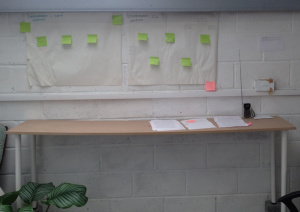 The planning desk
The planning deskDeary also talks about rooms as ‘spaces of embodied routines’; how repeatedly using a place in a certain way creates powerful behavioural cues. When I sit at my desk at home, it’s automatic to check email – but when I walk into the studio first thing in the morning, it’s automatic to flip open the laptop and begin work where I left off the previous day. And for me, sharing a studio with artists taps into older behavioural cues: having spent four formative years at art college, working in a creative visual environment somehow facilitates my own imaginative work in a completely different medium.
‘Without this room,’ says Deary, ‘I’m just a guy with a notion for a book. Equally, without me this room is, well, just weird. Together, the room and I can do stuff that alone would be impossible.’

May 27, 2015
eBooks and digital immigrants
Apparently, today is Scottish eBook Day. Did you know this was a thing? No, me neither. But why shouldn’t there be a day to celebrate eBooks? The ease of reading and publishing in digital formats has shaken up the world of books, largely for the better. eBooks are arguably greener than their paper sisters, and the format is certainly more accessible for anyone with a visual impairment.
I was a fairly late adopter of eBook technology, but by the time my brothers, my sister and my 70-something parents had all fallen for their Kindles, I decided it was time to make the jump.
Pretty soon I was a convert, won over by price promotions and the instant availability of any title that might catch your eye. I remember running out of books halfway to the Outer Hebrides and downloading fresh sustenance on the deck of the CalMac ferry. I was reading more than ever before, racing through free classics, out-of-print gems and 99p daily deals.
Gradually, though, I noticed something odd about my reading. I kept forgetting things I’d usually remember – characters’ names, important plot points, even whether I’d read a book or not. Every book, every page looks alike on an eReader, and without the visual cues I was accustomed to – the jacket design that helps you remember a title; the typography that subtly contributes to the overall feeling of the book; the placement of a sentence on the left or the right-hand page, top or bottom, near the start of the book or close to the end – my recollections were hazy. I still enjoyed what I was reading, but once I’d moved a book to my ‘read’ collection it slid too easily out of my mind.
My reading these days is 95% hard copy. Library books are even cheaper (and greener) than eBook promotions – and since I’m studying for a PhD, paper allows me to flip quickly to indexes and footnotes, and to annotate with pencil scribbles and sticky tabs. I still use my eReader for travelling, and for reading completed manuscripts; I’ve found it’s helpful in creating the distance you need in order to approach your own work, as far as possible, as a reader rather than an author. But if the digital world is divided into natives and immigrants, I’m in the latter camp: even at the editing stage, sometimes you can’t beat a print-out, a pair of scissors and some sellotape, sticky notes and a trusty red pen.

April 29, 2015
Tips for terrified authors
For many people, speaking in public is a genuinely frightening ordeal. Years ago, I studied on a course that was assessed partly on a presentation to my (small, friendly) student group; for months in the run-up to The Day, I existed in a state of anxiety, falling asleep each night to self-hypnosis tapes in an attempt to manage my fear.
Fifteen years on, I may still get a flutter of nerves before stepping in front of an audience, but that crippling fear seems like nothing so much as a bad dream. Over the last month, I’ve appeared on local TV; held three launches for my debut novel; performed a reading and Q&A at an author event in Switzerland; and taken part in an advice panel for postgraduate creative writers. There’s no way round it: if you’re an author, public speaking is increasingly part of the job.
So if the prospect makes your palms sweat and your heart skip – if you’re breathless right now at the thought of it – how can you learn to endure, and even enjoy, the experience? Here are five tips that helped me to feel confident in front of a crowd.
1) It’s not about you.
When I started teaching creative writing, this was my mantra. In those early days, remembering that the focus was not on me but on my students allowed me to feel comfortable in the classroom. But surely appearing at an author event means it is about you? I prefer to think it’s all about the book. The book wants to be read – and it’s my job to bring it to life for potential readers.
2) Be prepared.
Being thoroughly prepared for an event can help you feel more secure. Attend other author events to get a sense of the questions you might be asked; think about how you might respond, and jot down some notes. Practise reading aloud; record yourself, so you can fine-tune your performance to make sure it’s engaging. And if you always read your work aloud as part of the writing and editing process, you’re one step ahead – you’ve already put weeks of effort into making your prose sound great.
3) Keep it brief.
Short is always good when it comes to book readings. It can be reassuring to know that you just need to reach the end of the page without your voice going AWOL – and since it can be hard for listeners to stay focused on longer extracts, the audience will thank you too. Similarly, if you’re new to speaking in public and the idea of giving a five-minute reading makes you deeply anxious, try not to be persuaded too far and too quickly out of your comfort zone: an hour-long discussion about the themes of your novel, for instance, is something you might want to build up to gradually.
4) It’s normal to be scared.
Fear can be deeply physical: you may feel unsteady, light-headed, dry-mouthed … the list goes on. There are some practical things you may be able to do to conceal these physical signs of nervousness: sitting rather than standing, leaning on a lectern, using a mic, having water to hand. But really, so what if people notice your hand is shaking, or hear the wobble in your voice? We all know how hard it is to be the centre of attention: the audience is on your side, willing you to do well.
5) Get older.
An easy one, this! The fear of speaking in public is often tied up with insecurities about how others perceive us. But time is on your side, since one of the great liberations of growing older is caring less what people think. Perhaps one day you’ll face your audience wearing purple, with a red hat which doesn’t go, and doesn’t suit you.

April 10, 2015
School for storytelling
Here’s something I’m not meant to tell you: my first novel, The Last Treasure Hunt, isn’t really my first novel. It’s my debut – but it’s not the first book I wrote. Though it’s rarely acknowledged, there’s nothing unusual in this: a 2010 survey found that the average number of novels an author writes before being published is between three and four. These ‘practice novels’ are sometimes published later on in an author’s career, but more commonly they’re relegated to a dusty box-file or a forgotten Word document…
I wrote this post on developing storytelling skills as a guest blog for for Literascribe – head over there to read the rest.

March 31, 2015
Mapping the city
From James Hogg to Ian Rankin, Robert Louis Stevenson to Alexander McCall Smith, Edinburgh is incredibly rich in literature – perhaps uniquely so for a city of its size. Walking the city it often feels as if you’re in the company of scores of writers, and last night saw the launch of a project that aims to make that feeling a reality.
LitLong is a database and app that weaves thousands of literary texts into the geography of the city. Download the app, and as you wander through streets, parks and closes it will guide you to key locations and show you how authors have written about them. You can also search the city from the comfort of your laptop – and there will even be a ‘sentiment visualiser’ that will analyse whether a location is associated with positive or negative emotion. The app was demonstrated at last night’s launch, and it looks like an amazing way to bring literature into an everyday context and give a sense of how extensive and deeply layered Edinburgh’s literary history is.
It’s not just about the history, though. LitLong includes work by several contemporary authors, and as part of the project the organisers ran a competition for writers to contribute a story to the database. I’m delighted that my story Candlemaker Row was chosen from a shortlist of five: Keith Dumble, Ricky Brown, Sandy Thomson and D.R.D. Bruton were all highly praised by Doug Johnstone, who judged the contest.
Because Edinburgh is so written about, it was difficult to find a fresh perspective for my story. My solution was quite radical… You can read Candlemaker Row here, in its entirety – and if you happen to be wandering past Haymarket, through the Grassmarket and up Candlemaker Row, you’ll be accompanied by snippets of my text along with quotes from Sir Walter Scott, Muriel Spark, Irvine Welsh and hundreds more.
Lit Long: Edinburgh is the visual, interactive output of the Palimpsest project, a collaboration between the University of Edinburgh’s School of Literatures, Languages and Cultures; the School of Informatics; the University of St Andrews’ SACHI research group; and EDINA. Download the app here.

March 16, 2015
Pitching the story
One of the trickiest things about writing a novel, I’ve found, comes after you think all the hard work is finished. The ‘elevator pitch’ is a short summary or hook that has to convey the essence of your story, and make people want to read it. Many writers weep at the thought of writing a synopsis – and yes, synopses are far from my favourite things – but for me, having to come up with a few sentences that condense and sell the book (whether that’s to an agent, a publisher or a reader) is unfeasibly hard.
In conversation, I hear myself telling people that the novel is kind of about this, and sort of like that … which of course sounds very vague and unformed, and doesn’t exactly promise a rewarding read. But kind of and sort of is my natural territory as a writer. I’m interested in exploring ambiguities, and in opening up questions rather than making statements. In life, I can generally see both sides of an argument or a position, and similarly in fiction it’s the grey areas I’m drawn to – whereas an effective sales pitch is far more black and white. Still, given my marketing experience, I ought to be better than I am at this pitching business: much of the work of branding and copywriting is about drilling down to the essence of things.
Partly, the difficulty is with how close you are to your own work – so just as you need an editor to look at your novel with an outside eye, asking someone else to draft your elevator pitch could at least give you a good starting point.
And it might give you something much better than that. The very clever Jenny Hamrick has created a trailer for The Last Treasure Hunt, and it’s a stronger hook than any I’ve come up with. From now on, whenever someone asks me what the book is about, I think I’ll just pull out my phone and show them this…

March 10, 2015
Introducing ‘This Is How We Make It’
For years I’ve had a geeky fascination with how creative people work: how they organise their days, how they make a living, how they’ve managed to carve out a career of sorts – so it’s partly to indulge my own nosiness that I’m publishing a series of interviews with writers, artists, musicians, actors and creative people of all kinds.
For people who choose this kind of work there are no set career paths, no annual appraisals or HR support; instead, we need to learn from each other – about making opportunities, coping with difficulties and how to keep going. So in addition to giving me the chance to talk to all sorts of interesting people, the hope is that This Is How We Make It will grow into a useful resource for anyone who’s pursuing a creative passion, or dreaming of doing so.
Read the first interview now, with painter Jayne Stokes – and look out for the next interview with writer Viccy Adams, coming soon.

February 19, 2015
The story behind the story…
Sometimes a story comes out wrong, no matter how many drafts you write, or how many sacrifices you make to the gods.
When that happens there are various tricks you can try. Put your story in a drawer for a week, a month, a year. Write it from someone else’s perspective. Turn your idea back-to-front. Start from scratch, and ask whether you really know what you’re writing about. And sometimes what works is to strike two different stories together, and make some interesting sparks. That’s what happened with ‘In Yon Green Hill To Dwell’, which took three years to write, from first notes to final draft, and eventually won the 2014 Fiction Desk Ghost Story competition. You can read the story behind the story now on the Fiction Desk website.
New Ghost Stories II is just out on Kindle, and also available in paperback. One of the nicest features of the Fiction Desk anthologies (aside from the meticulous editing and elegant typesetting) is their writer’s award, where all the featured authors are invited to vote for their favourite story and the winner is awarded a £250 prize. I think it’s a recommendation for the anthology that I struggled to cast my vote… So if you enjoy a good haunting – whether literal or psychological – and would like to support a great independent publisher, you can buy your copy here.

February 3, 2015
Happy SA4QE!
Today would have been the 90th birthday of author Russell Hoban, who died in 2011. I discovered Russell Hoban in 2002, in a bookshop in Charing Cross Road. This beautiful split-image cover intrigued me:
The opening line drew me in, and the first short chapter captured me entirely.
The streets were lit but the sky was still light. She was waiting at a bus stop. A sign said BALSAMIC although there was nothing vinegary about the place, no friars and no Gilead in sight. There were nondescript buildings in warm colours, perhaps leaning a bit, perhaps painted on canvas. She was waiting for the bus; there were obscure figures queuing behind her.
That’s the second paragraph of Amaryllis Night and Day, and it brings together several of Hoban’s recurring concerns: blurred borders between what’s real and not-real, painting, London, and a playful exploration of language.
I’ve since read my way through most of Hoban’s novels at least once, often several times. He’s best known for Riddley Walker, which is certainly his most influential novel (David Mitchell and Will Self have both talked about how they drew on its extraordinary, broken language in their own experiments with future versions of English, in Cloud Atlas and The Book of Dave respectively). Riddley Walker is an astonishing, dense, infinitely re-readable book – but the far simpler Amaryllis Night and Day remains closest to my heart.
The same year I discovered Russell Hoban, SA4QE began. On every 4th of February, Hoban fans share quotations from his work – usually on yellow A4 paper (read Kleinzeit to find out why). Last year I left some of my favourite quotations in libraries and museums around Edinburgh:
This year I’ve planned badly – no yellow A4 paper! – but I’ll still be leaving quotations in appropriate places.. And if you don’t stumble across any yellow pages, you can follow SA4QE on Twitter and Facebook as well as russellhoban.org.
Some times theres mor in the emty paper nor there is when you get the writing down on it. You try to word the big things and they tern ther backs on you.

January 5, 2015
Music to write books by #2 – Now Wakes The Sea
Holy Songs was a Christmas present, and it’s made its way straight onto the Music to write by playlist. You can probably imagine roughly how it sounds from the ‘things we like’ section on the NWTS website – a list that includes spring reverb, dub, John Betjeman, tape loops, Kurt Schwitters, Musik aus der DDR and The BBC Radiophonic Workshop. Obviously, it’s going to be brilliant. It’s the sort of music you hear when you lean your head against the window of a moving car or train, all drone and loose, circular melodies. There are vocals buried in there somewhere, but the words are so indistinct they’re no distraction. It’s perfect writing music. The only problem is it’s not on Spotify – instead I’ve added the only NWTS track I could find – but you can stream or buy it from Bandcamp.
Also worth checking out, if you can find it: Addressing the Haggis, an excellent lo-fi collection of Burns songs from 2013, featuring my favourite ever version of ‘Charlie Is My Darling’. Music to drink whisky by!


